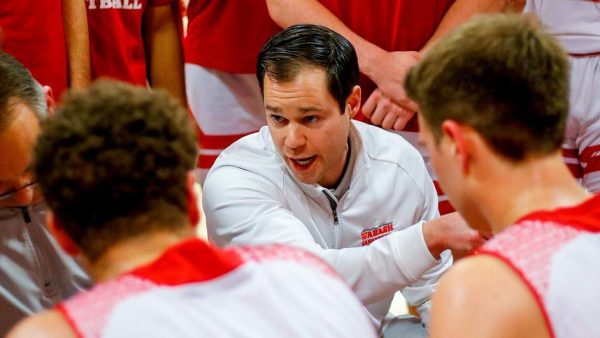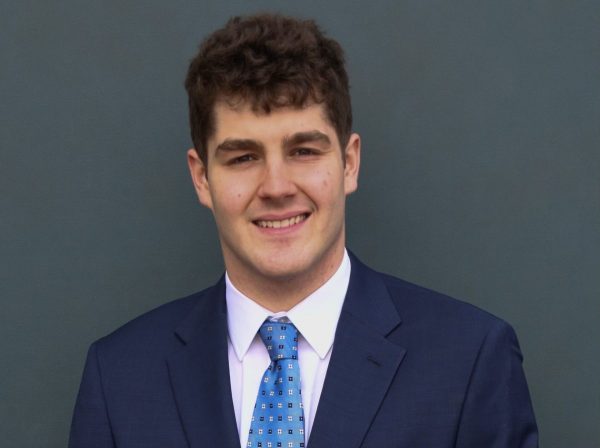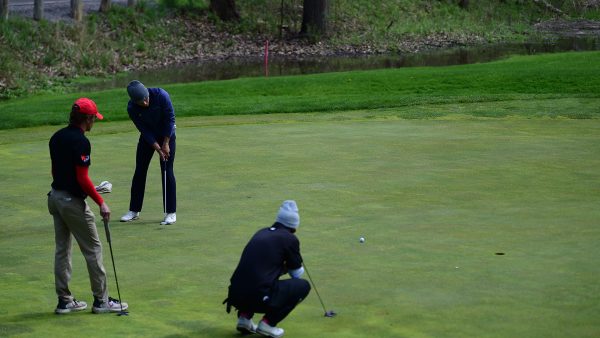Allegheny Aikido combines club sport and martial art

Robert Humphreys, Fukishidoin, demonstrates a series of movements with the jo as his students follow along on Feb. 18, 2019.
The David V. Wise Sport & Fitness Center is home to 21 varsity sports, four intramural sports and 13 club sports. From 7 to 8:30 p.m. Mondays and Wednesdays each week, the only martial art among these sports gathers in a dance studio in the Wise Center.
“The general philosophy of the club is to encourage nonviolent interactions and problem-solving,” said Christian Clark, ’20, Aikido club president.
Robert Humphreys, Fukushidoin, is a United States Aikido Federation (USAF)-certified instructor. The title “fukushidoin” refers to the lowest of three levels of instructors within the USAF.
Humphreys, who is known more simply to his students as “Sensei Rob,” led a class of five people with varying experience and skill levels on Feb. 18, 2019.
Humphreys recently taught a spring 2018 course on Aikido, but is currently only instructing students during evening club meetings. He and the members of Aikido club begin each hour and a half-long session of Aikido, an altruistic Japanese art, by removing their shoes and bowing as they enter the studio.
“The idea is that all the stresses of the day are like a backpack,” Humphreys said. “When you come in, and you bow, you take that off.”
After making any necessary introductions for new club members and arranging the studio with jo, or wooden staffs, at the front with a framed picture of Sensei, Humphreys begins warmups.
“(The jos) don’t have any inherent symbolism other than you being able to walk when you leave here tonight,” he said.
Humphreys, whose students describe him as “wonderful” and “a goof,” moves into a series of basic movements with the arms or legs, eventually incorporating careful movements with the jo. He then combines these smaller movements to begin to create a series of increasingly complex full-body movements.
“I like to compare it to learning the letters of the alphabet,” Humphreys said. “Before you can start to make sentences, you need to learn the letters.”
Humphreys punctuates his instruction of each movement with a demonstration of its purpose. An experienced student is called to the front to illustrate the way a shift of the arms and a step backward can redirect an attack.
Alexander Marrero, ’19, who is one such experienced student, speaks highly of Humphreys’s instruction.
“He’s an intellectual,” Marrero said. “I think he brings to the art a really high degree of receptivity. He’s really attuned to pushing you to pick up on the core principles. More often than not, that’s just by slowing down, shutting up, and practicing more.”
Humphreys incorporates those core principles into the way he teaches at Allegheny. At the Feb. 18 session, he paused between warmups and the core segment of the class to provide a basic survey of the history and philosophy of Aikido.
“Sensei’s philosophy was one of altruism, right?” Humphreys said. “He was trying to find a way to redirect the other person’s energy. When he was a young man, people still were having live sword fights in the street for honor.”
He explained that Aikido was born out of Morihei Ueshiba’s desire to stop the needless death and violence that came from constant disputes.
Ueshiba’s art was first practiced in Japan in the early 20th century. Ueshiba, who is now known as O-Sensei, or venerable one, was a student of multiple martial arts, according to the Aikido Association of America. His spirituality and sensitivity to the multiple conflicts he saw Japan embroiled in during his 1883-1969 lifetime drove him to create an art meant for “joining the people of the world together in peace.”
“We should be loving the world more than we fight with it,” Marrero said. “(Ueshiba) incorporated these spiritual principles into his art.”
Marrero explained that “simple shifts” like allowing someone to move past you when they move to hit your hand, as opposed to attacking them yourself, “make Aikido profoundly different.”
Humphreys said he tries to demonstrate these differences, and the general philosophy of Aikido, in the way he teaches each class.
“Instead of always trying to get there first and hurt the other person, what if I can redirect some of this energy?” he said. “It’s this idea of coming together in harmony.”
While Marrero commented that Aikido often gets a bad reputation when compared with the more obvious action and aggression of other martial arts, Aikido has grown to have an international presence under the leadership of Ueshiba’s son and now his grandson.
The art that now spans both countries and decades is, similarly to other martial arts, structured by ranks.
“It’s given by degrees of not expertise, but it’s kind of these stepping points at which you are expected to have matured,” Marrero said.
Students at Allegheny begin without rank until they take their first test, according to Clark, and enter the Kyu ranks at the sixth kyu level. At this point, Allegheny Aikido purchases the student’s United States Aikido Federation (USAF) membership and the student buys a gi, a traditional white uniform made up of loose-fitting pants a robe-like top tied with a belt.
From the sixth kyu level, a student can progressively work toward first kyu by taking a series of tests.
“Each test gets a little more rigorous,” Clark said. “Each test also takes a little bit longer to practice for. You have to practice for a set number of full practice days before you can take the next test.”
All kyu levels wear a white belt — one of two belt colors in Aikido. Students receive a black belt when they attain Dan status, which begins at first Dan.
“Technically, Dans can count up infinitely, but typically, people only reach sixth Dan,” Clark said. “Sixth Dan is like the technical ceiling.”
Students of Aikido at this level, who are referred to as Yudanja, are not “masters” in the commonly held notion of a black belt, Marrero said.
“Dan ranks are what we really call beginners because they’re expected to have enough principles of their art that they can really start studying,” Marrero said. “It’s kind of a recommitting.”
Marrero’s experience with Aikido and its intricacies has been inexplicably life-altering, he said. Marrero first began to explore Aikido with the help of a former instructor who was also seeking some “deeper principles” roughly seven years ago.
“I came to Allegheny and I found that there was an Aikido club, and I trained with (Humphreys) for about two years,” Marrero said. “Then I left Allegheny actually, and I entered a monastic internship in Aikido. Something like a monk, but not quite. I didn’t take any vows.”
Marrero’s internship in Burlington, Vermont consisted of performing day-to-day tasks like laundry and of approximately 40 hours of Aikido training per week.
The transition back to Allegheny was extremely difficult, according to Marrero, and over a year later, he is still adjusting. The presence of the on-campus club was vital to Marrero in his decision to return to college.
“Had I not had a place to do Aikido or a community to do Aikido with, I probably wouldn’t have come back,” Marrero said.
Clark said Aikido’s presence on campus has also been an instrumental part of his time at Allegheny almost from the time he came to campus.
“When I came to college, I was interested in martial arts, and I wanted to find a martial art to practice,” said Clark, who has now been practicing Aikido for two and a half years. “I was kind of surprised it was altruistic at first. It also kind of agreed with my principles anyway, and I just kept going.”
Clark said he was eager to be a part of a club “with people in gis throwing each other around on a mat” and was similarly eager to become president this year.
As president, Clark said he is hoping to implement changes to Aikido club this year, including creating a new website because the existing site has not been maintained since its former administrator graduated.
Clark said Humphreys stresses Aikido’s openness to any and all members of the campus community, who can walk into the weekly meetings with no prior experience.
“It’s not mandatory that you come to every practice,” Clark said. “You have the same status as people who have come to the club every day for the past three years.”
As someone who has years of experience with Aikido, Marrero emphasized just how valuable he thinks this particular club sport is.
“I think everyone should come to Aikido club,” Marrero said. “It changed my life. I lost 40 pounds and became a Buddhist. It did a lot for me. It’s not even life-saving, not even life-changing, it’s kind of like life-giving.”
Olivia Blakeslee is a senior majoring in English with a minor in journalism in the public interest. This is her fourth year on staff, and she is serving...







